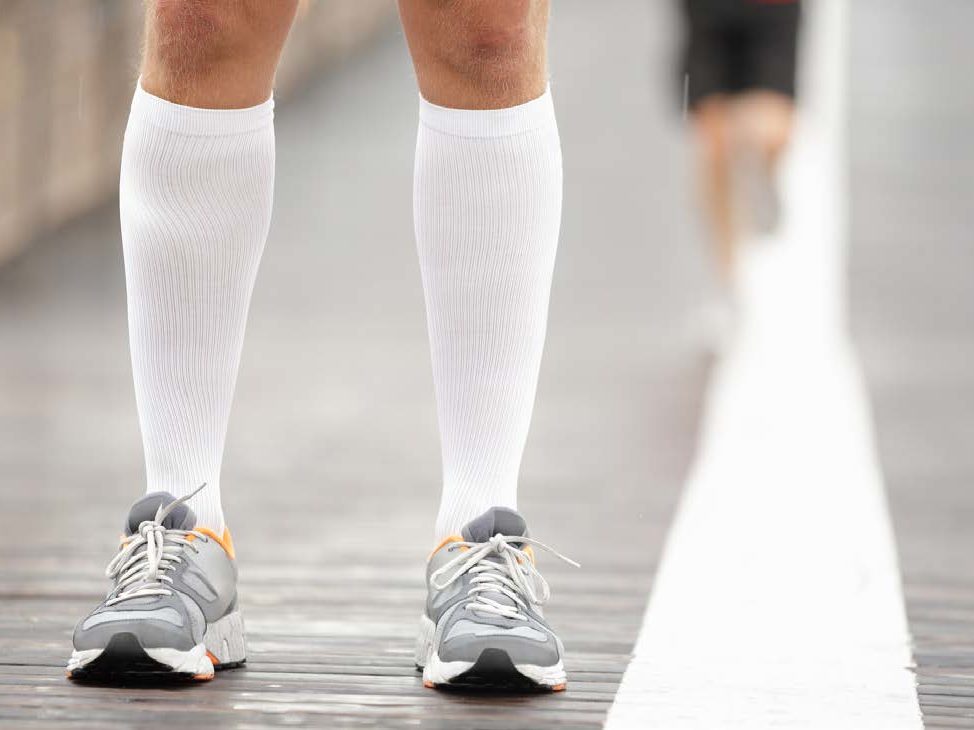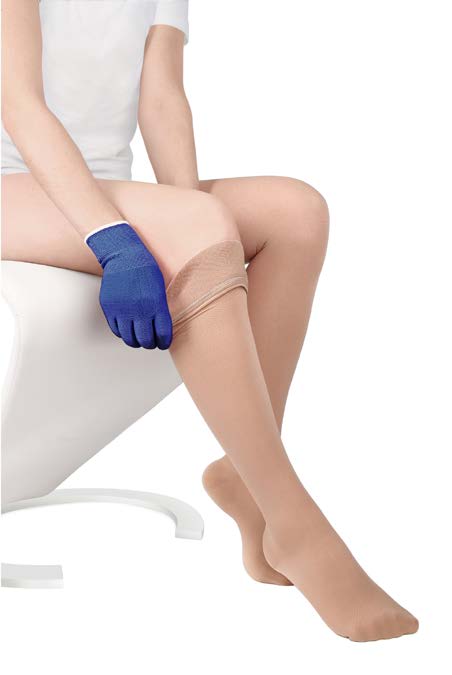Last updated on
Under Pressure: Compression Stockings 101
Compression stockings are a specialized type of hosiery that help improve blood flow in the legs. By placing pressure on the legs, the stockings prevent blood from pooling in the leg and encourage blood to flow freely to the heart.
Compression stockings are most often used to:
- Relieve leg swelling
- Relieve leg pain and other symptoms due to circulatory problems
- Manage symptoms associated with post-thrombotic syndrome (PTS)

There are two types of compression stockings. Uniform stockings apply the same amount of pressure to the entire leg. Graduated stockings have the most pressure (and are tightest) at the ankle; the pressure gradually decreases as the stockings move up the leg.
“While not everyone needs to wear compression stockings, many of my patients feel better when they do,” says Dr. Aaron Aday, a cardiologist and vascular medicine specialist at Vanderbilt University Medical Center in Nashville, TN and NATF Medical Advisory Board member. “Compression stockings are one of the few therapies we have to help people with leg swelling, PTS, and other vein problems and they can help prevent leg fatigue from sitting or standing for a long time. Using stockings can be daunting at first, so I encourage people to work with their medical team to find the right stockings and to understand how and when to use them.”
WHO TYPICALLY WEARS COMPRESSION STOCKINGS?
- Individuals who have leg swelling due to deep vein thrombosis (DVT)
- People who may have circulation problems (related to conditions like varicose veins)
- Patients who have just had surgery or are on bedrest
- People who frequently travel on long trips
- Individuals who are on their feet or at a desk for long periods of time
- Pregnant women
Compression stockings might not be the right option for the following people:
- Individuals with severe peripheral artery disease
- People with ulcers or wounds on their legs
WHAT SHOULD I KNOW BEFORE USING COMPRESSION STOCKINGS?
Not all compression stockings are the same! While you can easily find stockings online or at your local pharmacy, some stockings are available by prescription only. Like many over-the-counter medications and therapies, many stockings sold online or in a store are not equivalent to the stockings that are prescribed by a healthcare provider (HCP).
To get the most benefit from compression stockings, they must fit correctly. Your HCP can help you figure out both the right size and the amount of compression that you need.
Length and sizing: Stockings are available in knee-high and thigh-high lengths as well as in leggings or hose. Your HCP may prescribe different stockings depending on your personal situation. Several measurements may be collected to ensure proper fit, including the width of your ankles, length and width of your calves, the width of your thighs, and the overall length of your legs.
Amount of pressure: Stockings have different levels of tightness (compression). The amount of compression in stockings is described using millimeters of mercury (mmHg), which is a standard measure of pressure.
- Mild compression (light support) = less than 20 mmHg: Stockings up to 20 mmHg are typically sold online or in stores and are often used to relieve minor swelling or discomfort from standing for extended periods of time.
- Mild-moderate compression = 20-30 mmHg: These stockings are the most commonly prescribed and are often used to control swelling and pain following DVT or in people with varicose veins.
- Moderate compression = 30-40 mmHg: These stockings are typically used in people with more severe symptoms that are not controlled by stockings in the 20-30 mmHg range.
- Firm compression = 40-50 mmHg: These stockings are used in people with severe PTS or other vein problems, such as those with a history of venous ulcers.
TIPS FOR EASY USE:
- Hand wash new stockings with a mild soap to make the material a bit more flexible.
- If affordable, consider buying more than one pair of stockings. That way, you’ll have an extra pair on hand if the other pair becomes dirty or damaged.
- Put your stockings on when you first wake up. (You’ll typically have less swelling in your legs in the morning.) It helps to put stockings on with your back supported by a chair.
- Turn most of the stocking inside out before pulling it up your leg. Then put your toes into the toecap of the stocking and gently roll the fabric up your leg.
- Wearing rubber gloves may help you get a better grip on the fabric.

Compression stockings may cause some discomfort at first, but any soreness or aching should subside quickly if the stockings fit correctly. However, you should call your doctor immediately if you experience any numbness, significant pain, or discoloration in your legs or feet.
Compression stockings should be replaced every 5-6 months. If wearing a prescription pair, your insurance provider may cover some of the cost.
WHAT DOES THE EVIDENCE SAY?
“Data shows us that not everyone needs to use compression stockings after having a blood clot or undergoing surgery, especially if you’ve recovered quickly or are already on medication to prevent a recurrent blood clot,” says Dr. Aday. “It’s also not clear if compression stockings do help prevent PTS after a blood clot. However, many people feel better when using compression stockings, particularly if they experience swelling or discomfort due to vein issues. There’s ongoing research to better understand who will benefit most from using compression stockings.”
*Originally published in The Beat – June 2021. Read the full newsletter here.



